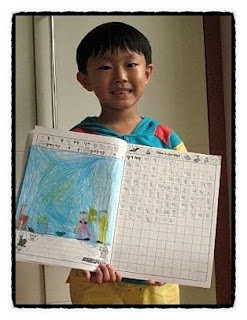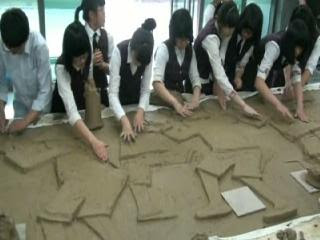My experiences with art education may be somewhat different from those of some people in this class due to my completion of K-12 and undergraduate study in Korea. All through my K-12 years, there were art classes—as well as Music, Physical Exercise, and Dance—in every grade. Most of the art courses were offered once or twice a week, and they were shorter than most classes, none meeting more than four hours per week. However, art was not one of the elective courses that students could choose to take or to avoid taking; it was part of the required curriculum.
Reflective Approach to Teaching Art
Saturday, April 30, 2011
초등학교 (Elementary School)
There were usually 12 units in each grade level. Each of the units had a teacher who was responsible for teaching all the subjects to his or her unit. I remember that most of students enjoyed the art classes. We were not provided with art supplies by the school or teachers. It was students’ responsibility to purchase and bring them to class, which meant that parents were responsible for providing them for their children. Of course, there were some families who could not afford the materials. The parents association, equivalent to PTA in the U.S., discretely provided these students with supplies. I also remember that the school collected rice and other basic supplies for students in need.
In looking back at the education I received, I find the strict Asian education system very interesting for both its strengths and its weaknesses. The most notable strength of this system concerned discipline and rigor in all disciplines. In art classes, we used both dry and wet media. In grades three through six, we were doing watercolor wash technique. We also learned calligraphy using ink and brush. Art classes were intended to train students in the handling of materials, and they usually succeeded in this training. I appreciate the education I received in all subjects, and it has served me well. But I wish that all of my education, including art education, were less focused on rigor and provided more individualized instruction in technique and more creative freedom in classrooms. In all subjects, students with better skills were commended and other students were not noticed much, but these were recognitions mostly of skills that students had brought into the class with them, innate skills or skills they had learned from parents or in private instruction.

Although the Korean school system has same spring and fall semesters, they are slightly different from the U.S.A. semesters. The Korean spring semester runs from March to June, and the fall semester is from September to December. We had a two-month break for summers and winters with assignments to be done at home in various subjects, including art. As art assignments during the breaks, students were required to visit at least one museum and one performing arts event. I also remember picture-diary assignments throughout elementary school, especially during summer breaks. Each page of a notebook/sketchbook was divided: the upper 60-70 percent was for visual expression and lower 30-40 percent was designated for the written portion of the diary. Students wererequired to keep the journal in this format and to submit it for periodical review. There were times that I felt tired of keeping up with the picture diary, but it was excellent way to train visual and written expression as a young child. It was nice way to connect everyday life with visual art.
I think such assignment for the breaks from school are very helpful in encouraging parents and children to spend time together doing the activities recommended by the schools/ teachers. My first musical experience came with my parents helping me to fulfill an assignment from the elementary school. It also benefitted my two younger sisters. They came to the musical event and enjoyed it very much. I remember that my youngest sister, who was about five years old, said, “It is good to have a sister who goes to school and has this kind of homework. I want to go to school on my own soon.”In my memory, the education and most of my teachers strongly implied that the arts are important because they nurture us emotionally. Without assignments like this, my formal experience with the performing arts would have been much delayed.
중학교 (Middle School)
 I attended a middle school that produced about the same number of graduates students as my elementary school, but they were all girls.Theschool had a similar structure: one teacher was responsible for each unit. However, the teacher did not teach every subject. There were subject teachers at this level. I remember having only two art teachers for the entire school. At this level, some teachers, parents, and students would start talking negatively about keeping art in the required curriculum because of the pressure of the high school entrance exams.
I attended a middle school that produced about the same number of graduates students as my elementary school, but they were all girls.Theschool had a similar structure: one teacher was responsible for each unit. However, the teacher did not teach every subject. There were subject teachers at this level. I remember having only two art teachers for the entire school. At this level, some teachers, parents, and students would start talking negatively about keeping art in the required curriculum because of the pressure of the high school entrance exams.After three years of study in the middle school system, students were taking exams to enter various types of high schools; two main types were a college preparatory high school and vocational high school. The national exam was held once a year for all the third-year middle school students, which created big pressure for many students and their families. Since studio art was not on the exam, some thought that it was not necessary to spend time learning studio side of the art. At this point, I saw some students losing their interest in art quickly due to the overwhelming exam preparation that was produced by weekly quizzes and monthly exams in all subjects. My art teacher often had to struggle to keep the studio art open. Otherwise, the school administration would strongly suggest that those hours be used to prepare for weekly and monthly school-wide exams. Looking back, the female art teacher had a great passion for art and act out her beliefs despite the pressure from the administration and parents. I think this was possible only because of the culture that respected teachers.
In the middle school, we were expected to work on drawing and painting from perception, which shows the emphasis on the hand-eye coordination. We also worked various materials and techniques, such as clay modeling, collage, soap carving, and cardboard sculpture. Art classes were demanding. We were expected to complete assignments and in-class projects that required 4-5 out-of-class hours each week on average.
 The education system made it clear that the top-ranked students were those whofocused on the technical matters, matters that could be measured quantitatively. I admit this competitive environment encouraged students to try harder because of the quantitative measurement in outcomes that many preferred in other subjects. I also believe that this type of educational structure discouraged some individuals from pursuing or enjoying art further, encouraging students to keep their passion for art as a secret.
The education system made it clear that the top-ranked students were those whofocused on the technical matters, matters that could be measured quantitatively. I admit this competitive environment encouraged students to try harder because of the quantitative measurement in outcomes that many preferred in other subjects. I also believe that this type of educational structure discouraged some individuals from pursuing or enjoying art further, encouraging students to keep their passion for art as a secret.
고등학교 (HIgh School)

Again, I went to the high school that was similar in size to my middle school. The Korean high school was all about preparing students for the college entrance exam. The system did not allow the general entrance to a college; students applied for the college and for their major together. There was less emphasis on arts courses except for the students who were applying to arts colleges. The majority of students focused on memorizing the written portion of the arts disciplines for the national college entrance exam (equivalent to SAT).
I was one of the students who decided to go to Art College early on, before entering high school. Naturally, my life revolved around preparing for the entrance exam specific to the art department I was applying to, which meant preparing for both national college entrance exam and studio art exams (observational drawing and painting/design) at the university. My weekday schedule consisted of work at two different schools; one for regular high school (7am - 6pm,) and the other for art instruction (7pm – 11pm or later). My weekend schedule was 9am - 2pm at the regular high school and 3pm – 8pm or later at the art institute. At this point, art was the profession I had in mind. It was a rigorous technical training that was required by the Art College.
I do appreciate the opportunity to learn the art techniques. However, I wish that I had more exposure to the conceptual side of art and to the social-awareness element art education.
Friday, April 29, 2011
나의 생각 (My Thoughts)
After reviewing my first-hand knowledge of art education in Korea, I appreciate the rigorous standards for all education there, especially for art education. As a person who was a general education student, an art student, and art educator for decades, I would like to propose that the following to be incorporated into Korea’s education system:
- Less competitive and more collaborative class environments;
- Adaptation of “glocalism” (balance between local and international cultural balance and respect), i.e., greater representation of Korean artists in textbooks, which would balance the Western artists who dominated when I was a student.
Currently, I am teaching art at a regional university in a small town in Oklahoma. I think my background of receiving Korean education is reflected on my teaching practice. I am continually work on finding a balance between the rigor and individual creativity.